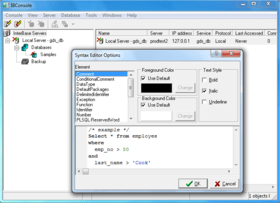Installing Interbase For Mac
Go Up to Before you get started, you need to do the following:. Go to and download the InterBase 2017 multi-platform kit.
Note: The InterBase 2017 download only includes a 64-bit installer. A Developer’s Network account is required. Click to either log on to an existing account or create a new one. Installation Starting with InterBase 2017 Update 3 there is a unified multi-platform installer follow for instructions.
DxO Film Pack lets you rediscover the magic of analog film. Give your digital photos greater emotional impact with this creative image-processing software. Rediscover the style, the colors, and the grain of more than 80 legendary analog films, faithfully reconstituted thanks to DxO. Dxo filmpack 5 for mac. DxO FilmPack 5.5.14 Elite Full Version Crack free to download the latest version is now available with the direct download link only at MacAppetite. DxO FilmPack 5 For Mac Keygen is a powerful analog film simulation and creative effects software that provides a greater quantity of analog film and progressive renderings, along with unique visual.
For instructions installing InterBase 2017 Update 2 and below refer to. Advance To:.
Which version should I get? For MacOSX, the download site only has a pre-built binary for the Firebird Classic Server, version 1.5.1. There is no binary available for the Firebird Superserver, however, a method for building and installing the Superserver version is included in section 4 of this document. As I was completing this document December 2004 , a point release 1.5.2 was released.

There are no pre-built binaries for OSX yet, but the procedure for building 1.5.2 from source is in a later section of this document. The difference between the Classic Server and the Superserver lies in the design approach. The Superserver uses threads to service multiple clients connecting to it at the same time, while the Classic Server was the original approach used in Interbase, which spawns a separate server process for every connection. Under MacOSX, xinetd is used to spawn a new process for each client connection to a database. A White Paper comparing the two approaches can be found. On MacOSX, the question of which server version to use does not arise as there is only one version available (unless you compile firebird yourself from source). For “ embedded databases” with few concurrent users, it should not make much of a difference which one you choose.
Theoretically, for applications with a wider audience, the Superserver should perform better by reducing process startup times and better sharing of resources. I have done some limited testing with our application and there is a noticeble increase in performance when the Superserver version of Firebird is used. This most likely due to the overhead of xinetd having to start new processes when using the Classic version. Installing Firebird In this example, I will assume you have created a directory called temp located in your home directory and all work will be performed in there. After you have successfully downloaded the zip file from the website, save it into your temp directory.
Open a Terminal window, change into the temp directory and execute the following command: $ cd temp /temp $ unzip Firebird-CS-1.5.1-MacOS.zip This will extract the Firebird insaller package into a directory named Firebird-CS-1.5.pkg inside your temp directory. To launch the MacOSX Installer program and process this package, you can use the open command in your Terminal window as follows: /temp $ open Firebird-CS-1.5.pkg Alternatively, you can use the Finder to navigate to your temp directory.
Double-click on the Firebird-CS-1.5.pkg directory to launch the MacOSX Installer. Follow the installer dialogs to complete installation of the Firebird software. This will install Firebird into the directory /Library/Frameworks/Firebird.framework. In order to use the command-line Firebird Administration programs such as gsec and isql, you must run them from the Terminal.
We need to make these binary files available to our Terminal sessions by adding them to our PATH. I did this by editing the.bashprofile file in my home directory, appending the following lines: export FIREBIRDHOME=/Library/Frameworks/Firebird.framework/Resources export PATH=$PATH:$FIREBIRDHOME/bin. Tip Unix people will feel comfortable using an editor such as vim or pico to make these changes. Alternatively, if you would prefer to use TextEdit, you can just type open /.bashprofile at the command prompt and the file will appear in a TextEdit window.


Installing Interbase For Mac
Add the above export statements to the end of the file, then save your changes. To verify that your changes have worked, open a new Terminal window, type isql then press enter. You should see the following: /temp $ isql Use CONNECT or CREATE DATABASE to specify a database SQL quit; Type quit; (dont forget the semi-colon!) to exit the isql program and return to your command prompt. If you have gotten this far, you now have a working Firebird installation running on OSX. → → Installing Firebird.